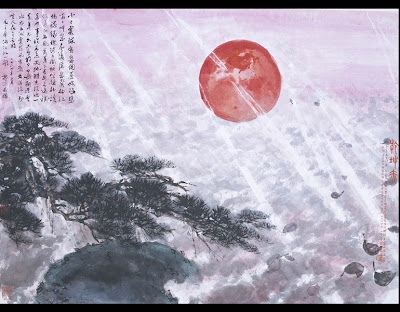 |
| Snow: Poem of Mao Zedong, 1958 |
 |
| Gottwaldov, 1957 |
Featuring 90 works on loan from the Nanjing Museum, one of the oldest and most comprehensive museums in China, the exhibition exposes the process of the artist’s self-discovery and personal struggle, as well as the complexity of art and politics in Republican and Communist China. The exhibition will be on view at the Cleveland Museum of Art through January 8, 2012 and will then travel to the Metropolitan Museum of Art in New York from January 30 through April 29, 2012.
 |
| Heaven and Earth Glowing Red, 1964. |
From traditional‐style landscape and figure paintings demonstrating Fu’s artistic excellence and profundity, to political artwork manifesting state ideology under Chairman Mao Zedong, the wide variety of work that will be exhibited demonstrates the artist’s search for an artistic language capable of speaking for both self and the nation. Fu Baoshi’s art provides an important insight into the use of native tradition to present modern Chinese ink painting as a discipline distinct from Western and international socialist art of the time. It was symbolic of the Chinese view of their place and national identity in the world during the twentieth century.
The exhibition focus on specific aspects of modern Chinese art during revolutionary change, including the reinvention of a national style of Chinese painting (guohua), the role of Japan in China’s modern art discourses and the new meanings of ink painting in the People’s Republic of China.
It traces the development and transformation of Fu’s paintings at different stages of his life as he embraced Chinese art history and Eastern aesthetics with his early experiences in Japan, developed individual styles in his 1940s landscapes and figure paintings, transformed ink and brush in service to the masses after the Communist victories in 1949, and captured China’s territories with patriotic conviction in his late landscapes of the 1950s and 1960s.
 |
| Qu Yuan, 1942 |
Highlights include Gottwaldov, a vivid image of the smoggy, industrial city of Gottwaldov (present day Zlìn) in the Czech Republic, painted during his official visit to Eastern Europe, as well as Heaven and Earth Glowing Red. Here, the red globe of the earth floats in rose-colored air. Natural phenomena, including a pine tree, rock, falling leaves, ocean, wind, mist and lightning, are incorporated in an abstract design for romanticizing Chinese communist revolution. This is Fu’s interpretation of the political abstractions of the time based on Mao’s poetry. It fulfills the political requirement to direct art in the service of the Party and the masses.
 |
| Mountain Spirit, 1946 |
 |
| Crossing the Dadu River, 1951. |
The exhibition will be accompanied by a catalogue that incorporates the most recent scholarship on modern Chinese art and provides in‐depth analysis of Fu Baoshi’s art, placing his art and career in the context of modern Chinese history. The museum is planning complementary programming including lectures, Chinese music performances, and films. More programming information will be available at www.ClevelandArt.org closer to the opening of the exhibition